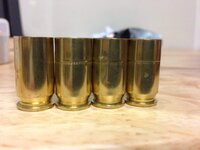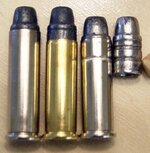I've been reloading for several years now, but have nowhere near the experience of many of you, so I figured I would ask here.
I recently came into 100+ pounds of mostly rifle brass recovered from grandpas barn, but there is a good portion of .45 brass as well. This is all from the late 60s and early 70s, mostly WCC headstamped. Most, but not all have a full crimp around the middle of the case, presumably at the base of the bullet. So, my question is this. Are these still safe to load, has the crimp compromised the integrity of the case? It obviously had been fired once in this condition and was fine. Is this just the way things were done before? Picture attached of what I am talking about. Three crimped, one is not...


I recently came into 100+ pounds of mostly rifle brass recovered from grandpas barn, but there is a good portion of .45 brass as well. This is all from the late 60s and early 70s, mostly WCC headstamped. Most, but not all have a full crimp around the middle of the case, presumably at the base of the bullet. So, my question is this. Are these still safe to load, has the crimp compromised the integrity of the case? It obviously had been fired once in this condition and was fine. Is this just the way things were done before? Picture attached of what I am talking about. Three crimped, one is not...


Last Edited:













